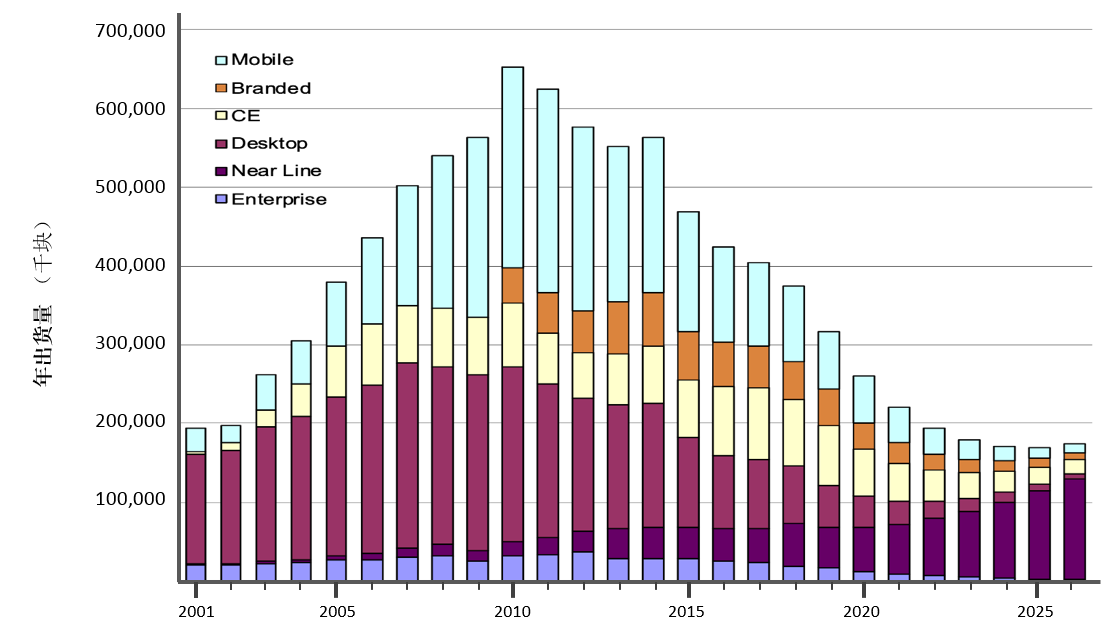
By: Tom Coughlin
Humans are storytellers.
We record and curate information, philosophies and perceptions for ourselves and our posterity. This is an essential part of our nature. With the advent of digital storage technologies, those stories have become digital stories and include our personal information, recollections and interactions with others. But in addition to our communication between ourselves, we have new narratives that include communication and on-going dialogs between us and our machines and machines communicating with each other. With the growth of IoT, AI with big training sets, the growth of engineering and scientific data and other sources of big data, the demand for digital storage now and in the future, is staggering. These new stories, whether generated by humans or our machines, are driving our demand for digital storage.
The demand for digital storage has grown with our ability to process data. The development and manufacturing of digital storage technologies has been an international effort and Singapore has played an important role in this industry. This article will talk about some of the innovations that have led to the modern digital storage industry, with some discussion on the role of Singapore in developments in the hard disk drive (HDD) industry.
A Brief History of HDDs
Digital magnetic storage technology started with the Univac computer in 1951 and with IBM’s first digital tape product in 1952 (Its Model 726). Magnetic digital tape provided a good storage media, but data could only be accessed sequentially, as the magnetic tape passed over the read/write heads.
Accessing data at random would improve the access to data for computers, allowing them to operate faster. For this reason, IBM created its IBM 350-1, the first hard disk drive, which was announced in 1955 and began shipping in 1956. This drive housed 50 24-inch disks, had an access time of 600 milliseconds, and a capacity of a few Megabytes. The IBM 350 disk storage was a major component of the IBM 305 RAMAC (Random Access Memory Accounting) system, which also included a processing unit, a printer, and punch card facilities. The system filled a large room.
From the 1950s through the mid-1970s HDDs were used for storage in large expensive dedicated computer systems. HDDs were less expensive and slower than main memory (which was originally core or drum memory and latter semiconductor memory) and faster and more expensive than magnetic tape drives. In 1973 IBM introduced its IBM 3340 “Winchester” disk drive and the 3348 data module. The IBM 3340 introduced important developments in the heads and disks that influenced many generations of future HDDs. In 1973 Control Data introduced its storage module device (SMD) disk drives using disk packs that became a dominant HDD used in the minicomputer market into the 1980’s. The number of HDD companies increased through the 1970’s, with about 40 companies making these products by 1979.
Personal computers (PCs) first became available in the 1970s with the introduction of inexpensive microprocessor chips, such as the Intel 8080. This led to the introduction of the Altair 8800 (a kit computer) and later the Apple I and Apple II, Commodore PET, Atari and TRS-80 computers. Towards the end of this era, smaller form factor HDDs, particularly 5.25-inch HDDs, were introduced. These products were designed for smaller computers, including minicomputers and microcomputers (also known as personal computers, PCs).
The IBM PC was introduced in August 1981. It was based upon an open architecture with circuit board cards that were inserted into a standard interface. This architecture allowed third parties to create cards that enabled various additional capabilities. The first model of the IBM PC used an audio cassette for external storage and an expensive 5.25-inch floppy drive was also available. IBM introduced its PC/XT in 19835 The XT computer added a 10MB HDD in place of one of two 5.25-inch floppy disk drives. The hard disk drive in the IBM PC/XT was the ST412, manufactured by Seagate Technology.
Through the 1980s and into the 1990s various HDD interfaces and form factors were developed. This period saw the creation of new form factor hard drives to serve the market for smaller computers and eventually digital consumer products. Rodime (a Scottish HDD company) introduced the first 3.5-inch HDD in 1983. This form factor enabled building smaller desktop computers. PrairieTek introduced the first 2.5-inch HDD in 1988, designed for notebook computers. In 1991 Integral Peripherals introduced the first 1.8-inch HDD. This HDD form factor would go on to be used in ultralight notebook computers and eventually in consumer products, including the first Apple iPod (in 2001). In 1992 HP introduced a 1.3-inch HDD that was used in the ill-fated Apple Newton personal digital assistant. In 1998 IBM introduced a 1-inch HDD for mobile consumer applications.
During this long period of HDD history, the industry grew from a volume of several thousand disk drives per year in the late 1950’s with a cost per megabyte (MB) of $2,057 in the early 1960s to a peak of about 650 million HDD per year in 2010 as shown in Figure 1 below. Today the costs of storage on HDDs are less than $0.02 per gigabyte (GB) ($20/TB) for large volume customers.

The declining costs of HDD storage was due to rapid development of hard disk drive technologies that allowed increasing the amount of data on individual hard disk drives plus the economies of scale resulting from higher volume production, particularly as the industry consolidated, with only 3 firms (Seagate Technology, Western Digital and Toshiba) making HDDs by 2021. The increase in storage capacity in HDDs was driven to a large extent by increases in areal density (the amount of data that can be written on a unit area of the disk surface) up through 2010 and with another burst of increased in 2015 and 2016 as shown in Figure 2. This capacity increase was enabled by ever more advanced write and read head and recording media technologies as well as ever more sophisticated head positioning and data recovery technologies.

In an effort to supply higher capacities in 3.5-inch nearline HDDs, the only significant growth segment of the HDD industry today, HDD companies, starting with Western Digital in 2013 began to ship hermetically sealed HDDs filled with helium. Today all three remaining HDD companies ship helium filled HDDs for their highest capacity products. The reduction in flutter in the rotating disks in helium compared to air allowed the use of thinner disk and consequently more disks and heads per drive.
In 2020 and early 2021 Seagate, Western Digital and Toshiba all announced advanced HDDs with higher areal densities using energy-assisted magnetic recording. This included heat-assisted magnetic recording drives with 20TB of capacity by Seagate and 18TB HDDs from Western Digital and Toshiba using a form or microwave-assisted recording (Toshiba) and with a bias current on the write head (WDC). In early 2021 Seagate projected that HDDs with storage capacities of 50TB will be available by 2026 as shown in Figure 3.

In addition to higher capacity using energy-assisted magnetic recording, the HDD companies are planning to make dual actuator products available for their highest capacity products by 2022-2023 in order to improve the performance to capacity ratios.
Singapore’s Role in the HDD Industry
The initial production of HDDs was of smaller production volumes and occurred in the Europe, Japan and in particular, in the USA. In the early years, HDD production was done by firms such as IBM that created the large computers that these HDDs connected with. By the mid-1980’s over 80 companies were making HDDs for mainframe computers, minicomputers and PCs. Particularly in the PC industry, there was intense competition between the many companies competing to supply the burgeoning demand for PC hard disk drives.
During the 1980’s, the HDD industry began production plants in Singapore, as the Singapore government was giving tax subsidies and capital subsidies for plant construction. Seagate was the first HDD firm to move its production to Singapore with component assembly by 1982 and full HDD assembly by 1983. Within two years of moving, Seagate transformed into a leading HDD manufacturer. A plethora of then-small U.S. HDD firms followed Seagate’s lead and began producing drives in Singapore, including Tandon and Computer Memories in 1983, Maxtor and MiniScribe in 1984, Micropolis in 1986, Conner Peripherals and Cybernex Advanced Storage Technology in 1987, and Western Digital in 1988.
In addition to the HDD companies, supporting component companies relocated production to Singapore at one time or another. Over time the HDD companies moved from Singapore and expanded to Thailand, Malaysia, China and other Asian localities.
The criteria that establishing these Asian manufacturing operations were a combination of government subsidies, educated labor force, lower labor rates, and country infrastructure that allowed sub-components to be produced by qualified local companies. In Singapore, an advanced education system in the country’s universities and in government supported laboratories, including research and development, was developed to produce qualified job candidates to meet corporate production goals. As a consequence, Singapore institutions continued to supply significant research and analysis capabilities for the HDD industry into the 2010’s.
Other Storage Technology Developments
We started this article to talk about the introduction of digital magnetic tape technology in 1951-1952 by Univac and IBM. Digital tape is still in use in many institutions for long-term data retention and as a layer of protection from malware. The most popular magnetic tape format today is linear tape open (LTO) tape, which is now into its 9th generation product with a native (uncompressed) storage capacity of 18TB. This 70+-year-old technology is the least expensive storage media with costs per GB of less than $0.01 per GB (<$10/TB).
NAND flash memory was announced by Toshiba in 1987. Over the years NAND flash has gotten less expensive and has, over time, become the dominant digital storage technology in consumer devices, and becoming the dominant storage technology in notebook and desktop PCs. The nonvolatile digital storage in cell phones uses NAND flash memory. NAND flash, like HDDs, must be combined with a controller that manages the operation of the flash memory. This configuration is usually called an SSD.
In the 1990’s NAND flash memory cards enabled the consumer electronic camera industry. By the end of the decade NAND flash was going into more applications, including the development of USB based handheld storage devices, which quickly replaced the once ubiquitous floppy disk. A Singapore company Trek 2000 launched its ThumbDrive product at the 2000 CEBIT international trade fair. The time appeared to be right in 2000 for this product, since M-Systems, based in Israel, also introduced its USB flash drive in 2000, working with IBM, after having filed a US patent on the device in 1999. As flash memory prices declined, they began to replace 1-inch and 1.8-inch hard disk drives used in early music players and enabled the growth of smart phones.
In the 2000’s NAND based solid state drives (SSDs) using the same interfaces as hard disk drives, were on the market, both for consumer and for enterprise applications. These devices had higher performance than HDDs (faster read and writes, but they initially suffered by early wear out. With the increase in SSD capacities and improvements in the controller algorithms for managing wear on the flash memory cells, SSDs became useful for more applications.
By the mid-2010’s SSDs were starting to have enough capacity that users would pay for that they began to make serious inroads on what had been the biggest hard disk drive market—notebook and desktop computers. This is a major factor in 2010 being the peak year for HDD annual shipments.
As SSDs became more popular, they inspired the development of a new storage device interface, NVMe, that provided even better SSD performance, since it doesn’t have the overhead built into SATA and SAS interfaces, originally developed for HDDs. Samsung announced the first NVMe SSD in 2013. Also, systems designed only for SSDs started to become popular, leading to new, more compact, SSD form factors.
Today, SSDs are the storage in the majority of notebook computers and are becoming dominant in desktop computers as well. In enterprise storage systems and large data centers SSDs are now the primary storage for data stored for active processing. Higher capacity, nearline HDDs are the dominant secondary storage for less active data. Magnetic tape is used for inactive or archived storage and to provide for an off-line copy of important data.
Figure 4 shows our projections for shipping storage capacity of magnetic tape, HDDs and SSDs.

While HDDs will continue to store the bulk of the world’s data out to 2026, the share of data stored on SSDs will increase. Today’s storage tiers provide the combinations of performance and costs of storage that enable working with the explosion of data generated by IoT sensors and cameras, scientific and engineering data and big data for AI application processing.

About the Author
Tom Coughlin, President, Coughlin Associates is a digital storage analyst as well as a business and technology consultant. He has over 40 years in the data storage industry with engineering and management positions at several companies.
Dr. Coughlin has many publications and six patents to his credit. Tom is also the author of Digital Storage in Consumer Electronics: The Essential Guide, which is now in its second edition with Springer. Coughlin Associates provides market and technology analysis as well as Data Storage Technical and Business Consulting services. Tom publishes the Digital Storage Technology Newsletter, the Media and Entertainment Storage Report, the Emerging Non-Volatile Memory Report and other industry reports. Tom is also a regular contributor on digital storage for Forbes.com and other blogs.
Tom is active with SMPTE (Journal article writer and Conference Program Committee), SNIA (including a founder of the SNIA SSSI, now CMSI), the IEEE, (he is Past Director for IEEE Region 6, Past President of IEEE USA, Past Chair of the IEEE New Initiatives and Public Visibility Committees and active in the Consumer Electronics Society) and other professional organizations. Tom is the founder and organizer of the Storage Visions Conference (www.storagevisions.com as well as the Creative Storage Conference (www.creativestorage.org). He was the general chairman of the annual Flash Memory Summit for 10 years. He is a Fellow of the IEEE and a board member of the Consultants Network of Silicon Valley (CNSV). For more information on Tom Coughlin and his publications and activities go to www.tomcoughlin.com.




































